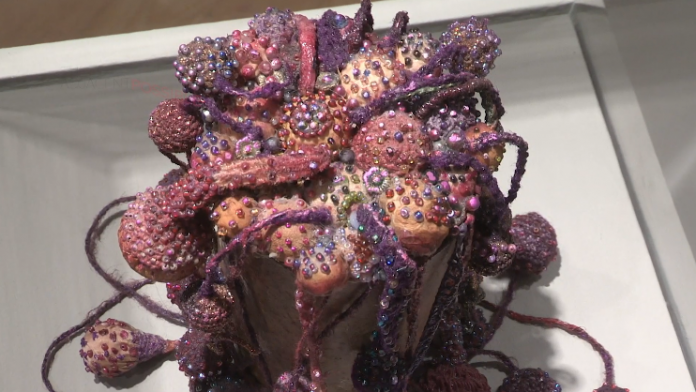Finding a common thread between two topics that have seemingly no involvement with one another may seem difficult to accomplish, but at the Muscarelle Museum of Art’s newest exhibit, “The Adjacent Possible,” art and neuroscience meet in order to create an art collection that stimulates the mind and piques interest in the meaning of the artwork.
Professor of art and art history at the College Elizabeth Mead was the curator for this exhibit. Working in conjunction with professor Jennifer Stevens, a professor in the department of psychological sciences and the neuroscience program at the College, Mead was able to create this neurologically exciting exhibit.
“We have this idea sometimes, those of us who aren’t trained or versed in abstract or modern art, and people often feel like they’re supposed to get the message,” Mead said. “These things take time to reveal themselves.”
The pieces that were chosen for the exhibit are all abstract, in order to play towards Mead’s goal of creating an exhibit that would stimulate the mind. The exhibit stresses the concept that art cannot always be understood in an instant. It can take time and patience to find the deeper meaning that the artist intended.
“What I’m hoping is that students learn that it takes time,” Mead said. “There are relationships to complex systems … everything moves simultaneously.”
Mead emphasizes the idea that with abstract works, it can be especially challenging to understand the piece.
“Work is not necessarily linear, each of the artists in this exhibition sort of go where the work needs to go for the work to arrive where it needs to arrive,” Meade said. “You never know that you were going to end up over there until you started down the road.”
Many of the artists that Mead chose to include in the exhibit create pieces using unusual mediums, whether they work with unorthodox materials or simply use art styles in an unusual form. These different styles help to create Meade’s desired effect, where it is impossible to understand the meaning of a piece immediately after walking in.
“What I was looking for were people who didn’t pay attention to boundaries,” Mead said. “Their works sit on a shelf, and it’s made of constructed wood, but Helen O’Leary thinks of herself as a painter. Michelle Benoit has the Lucite-acrylic pieces, but they’re built up.”
One such artist is Pamela Farrell, who doesn’t work within standard forms of art.
“I am invested in abstract and painterly sensibilities, and water, light, and time; all themes that are important to me,” Farrell said in an email. “The work Elizabeth chose for Adjacent Possible, oil on panel, and digital photo-based prints, reference water in several ways. The prints are made from photo imagery of photo-flash illuminating water spray at a dam spillover not far from my house. The paintings are more reflective of the slow flow of the canal water from which flows the water into the spillover.”
By combining her artistic methods with things she finds in her everyday life, such as the water and light in her backyard, Farrell adds a personal touch to her artwork. Farrell is also a psychotherapist in addition to being an artist and attributes a lot of her work to her interactions with clients.
“So much of the emotional energy that comes and goes from the dynamic interactions with clients seems to find its way into my work, though not necessarily by intention,” Farrell said. “So many internal experiences cannot be expressed with words, but rather are a felt sense. I believe this is what tends to show up in my work.”
The artists involved in the exhibit have all poured personal emotion into their works, which creates more of a mystery towards their meanings. The Adjacent Possible exhibit aims to stress this feeling of mystery in order for students to gain more of an understanding towards what it means to ‘get’ art.
Diane Englander, another artist whose works are currently in the exhibit, was able to fully embrace the combination of art and neuroscience.
“I want, always, to end up with a piece that both calms and invigorates simultaneously, but how I get there depends on what my material of the moment is,” Englander said in an email.
Mead said she wanted to curate an exhibit that left guests wondering, while simultaneously giving them the tools to understand art better.
The Adjacent Possible is only in the Muscarelle until Sept. 27, but Mead is hoping to have it reopen next fall with a new collection of artists. There will be a talk with Susan York, one of the artists in the exhibit, Sept. 20 from 4:00-5:30 p.m. in Andrews Hall. Afterwards, a reception will be hosted with York and some of the other artists, and they will be available to talk more about the meanings of their artworks and what this exhibit meant to them. Sept. 26, Christopher Delaurenti, a music professor at the College, will be putting together and performing a piece that is a response to the exhibition.
Englander spoke to the ability of art to keep her on her toes, constantly providing new experiences and inspiration.
“I’m always wondering, what will happen next?” Englander said.


[…] Source link […]